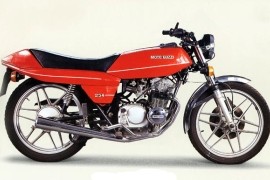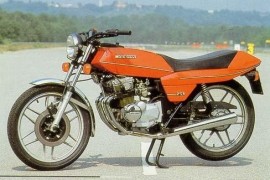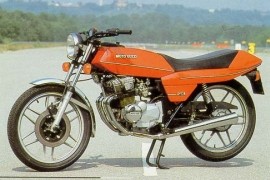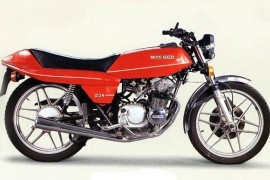MOTO GUZZI 254 Models/Series Timeline, Specifications & Photos
First production year: 1977
In the 1970s, the car manufacturer Alejandro de Tomaso bought both Moto Guzzi and Benelli companies. From that point, Badge engineering was used, resulting in numerous models sold under both brand names.
One example is the Moto Guzzi 254, also sold as the Benelli 254 or Benelli 250 Quatro. It was the smallest four-cylinder displacement motorcycle at the time, manufactured from 1977 until 1984.
However, the Benelli and Moto Guzzi models differed, like the Benelli, which aimed at the sports market, while the Moto Guzzi 254 aimed at a more touring-oriented market. Also, the Guzzi version packed six-spoke wheels, while the Benelli model had three-spoke wheels.
In 1980, the Italian motorcycle manufacturer launched the Moto Guzzi 254, a naked motorcycle in its fourth year of production, featuring the same technical, visual, and performance specifications as previous models, without significant modifications.
The bike had standard fittings, like a large round headlight on the front, a small-capacity fuel tank, a one-piece dual seat, a four-into-two exhaust system, and six-spoke lightweight aluminum wheels.
As for the power figures, the 1980 Moto Guzzi 254 had its soul brought to life by a 231cc two-stroke air-cooled four-cylinder engine mounted underneath its fuel tank, fed by four Dell'Orto carburetors, delivering 28 hp with a peak force at 10,500 rpm.
In 1979, the Italian motorcycle manufacturer launched the Moto Guzzi 254, a four-cylinder motorcycle in its third year of production. It was perfect for riders searching for a lightweight, agile, and still powerful bike made by the House of Mandello del Lario.
The Moto Guzzi 254 was also sold as the Benelli 254 or Benelli 250 Quatro. It was the smallest four-cylinder displacement motorcycle at the time, manufactured by Benelli and Moto Guzzi, which were bought by Alejandro de Tomaso in the 1970s.
The bike was designed by Lino Tonti and styled by Paolo Martin. It was presented at the 1975 Milan Motorcycle Show and released into production in 1977. Although it was a four-cylinder machine, it was different in design than the larger 500/4 model.
It was equipped from the factory with standard features, such as a large round headlight on the front, a small-capacity fuel tank, a one-piece dual seat, a four-into-two exhaust system, and six-spoke lightweight aluminum wheels.
In the performance department, the 1979 Moto Guzzi 254 had its soul brought to life by a 231cc two-stroke air-cooled four-cylinder engine mounted underneath its fuel tank, fed by four Dell'Orto carburetors, delivering 28 hp with a peak force at 10,500 rpm.
Unlike the Benelli version, which aimed at the sports market, the Moto Guzzi 254 aimed at a more touring-oriented market. Also, the Guzzi version packed six-spoke wheels, while the Benelli model had three-spoke wheels.
In 1978, the Italian motorcycle manufacturer launched the Moto Guzzi 254, a four-cylinder motorcycle also known as the Benelli 254 or Benelli 250 Quatro. It was in its second year of production and packed the exact specifications as the previous model without modifications.
In the 1970s, the car manufacturer Alejandro de Tomaso bought both Moto Guzzi and Benelli companies. From that point, Badge engineering was used, resulting in numerous models sold under both brand names.
The bike was designed by Lino Tonti and styled by Paolo Martin. It was presented at the 1975 Milan Motorcycle Show and released into production in 1977. Although it was a four-cylinder machine, it was different in design than the larger 500/4 model.
In the visual department, the bike had standard features, such as a large round headlight on the front, a small-capacity fuel tank, a one-piece dual seat, a four-into-two exhaust system, and six-spoke lightweight aluminum wheels.
Unlike the Benelli version, which aimed at the sports market, the Moto Guzzi 254 aimed at a more touring-oriented market. Also, the Guzzi version packed six-spoke wheels, while the Benelli model had three-spoke wheels.
As for the power figures, the 1978 Moto Guzzi 254 had installed a 231cc two-stroke air-cooled four-cylinder engine underneath its fuel tank, fed by four Dell'Orto carburetors, delivering 28 hp with a peak force at 10,500 rpm.
In the 1970s, the car manufacturer Alejandro de Tomaso bought both Moto Guzzi and Benelli companies. From that point, Badge engineering was used, resulting in numerous models sold under both brand names.
The Moto Guzzi 254, also sold as the Benelli 254 or Benelli 250 Quatro, was the smallest four-cylinder displacement motorcycle at the time, manufactured by Benelli from 1977 until 1984.
The bike was designed by Lino Tonti and styled by Paolo Martin. It was presented at the 1975 Milan Motorcycle Show and released into production in 1977. Although it was a four-cylinder machine, it was different in design than the larger 500/4 model.
Aluminum and plastic were extensively used in the bike's development to keep the weight down to 117 kg (258 lbs). It featured a sleek styling with an uncluttered handlebar, the instrument cluster, and the master cylinder mounted in the fuel tank, which reduced its capacity to 8.5 liters (2.2 gal).
Unlike the Benelli version, which aimed at the sports market, the Moto Guzzi 254 aimed at a more touring-oriented market. Also, the Guzzi version packed six-spoke wheels, while the Benelli model had three-spoke wheels.
In the performance department, the 1977 Moto Guzzi 254 had installed a 231cc two-stroke air-cooled four-cylinder engine managed by four Dell'Orto carburetors, delivering 28 hp with a peak force at 10,500 rpm.



